
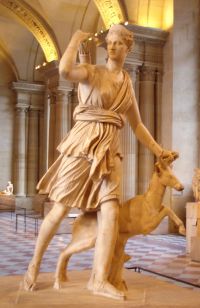
Summary: Artemis is the Greek Goddess of the Moon and the hunt. She is also one of the virgin goddesses, and She protects women in labor, small children and wild animals.
- names
- basic information
- relations
- magick
- symbol
- candle color
- planet
- herbs
- stones
- myths
- holy days
- Temple at Ephesus, one of the seven Wonders of the World
- Charge of the Goddess
- priests/priestesses
- links
- books
names:
Greek name: Artemis ![]()
Roman name: Diana, Diane
Etruscan name: Artume, Artumes
(NOTE: In addition to native variations by locality or over time, there are often several possible transliterations into the Roman alphabet used for English.)
Artemis was called Agrotora as the patron goddess of hunters.
Artemis was called Potnia Theron as the patron goddess of wild animals.
Artemis was called Kourotrophos as the nurse of youths.
Artemis was called Locheia as goddess of childbirth and midwives.
Artemis was called Cynthia, named after her birthplace on Mount Cynthus on Delos.
Artemis was called Phoebe, the feminine form of Phoebus (a name for her twin brother Apollo).
basic information:
Artemis: is the Greek goddess of the Moon and the hunt. She is also one of the virgin goddesses, and She protects women in labor, small children and wild animals. As a virgin goddess, She, Hestia, and Athena are not affected by Aphrodite’s (Greek goddess of love) manipulations. Artemis is the daughter of Zeus and Leto (sometimes called “Letona”) as well as the twin sister of Apollo. —Copyright © 1998 Andromeda
As a major lunar Goddess, Artemis is very popular among modern witches.—Copyright © 1998 Andromeda
Artemis’s relations:
Artemis was the twin sister of Apollo (sun and moon). Artemis was generally viewed as the daughter of Zeus and Leto, although there is a myth that she is the daughter of Demeter (the name of the father was lost to antiquity).
associations:
Artemis is associated with the ancient Egyptian goddess Bast, as well as the Roman goddess Diana. Artemis is also associated with Luna, Hecate, and Selene.
Derived in part and influenced by early worship of Ariadne, High Fruitful Mother Goddess of Crete.
magickal information and correspondences:
Symbols: Artemis is typically shown with a bow and arrow (representing the rays of the moon). Artemis was often shown being followed by a fox, stag, leopard, or lion (sometimes both a stag and leopard or both a leopard and a lion).
Sacred candle color: silver and white
planet:
Planet: Moon ![]()
herbs (and foods) associated with Artemis:
- almond
- amaranth
- cannabis
- cedar
- cypress
- daisy
- date palm
- hazel
- honey
- mugwort
- myrtle
- ox-eye daisy
- silver fir
- willow
stones associated with Artemis:
silver:
Artemis may be thought of as the “silver goddess.” She wore silver sandals, rode a silver chariot in the silver moonlight, and kills with silver arrows shot from a silver bow. In fact, many dying women, as well as women in childbirth, went to Artemis to ask for a quick, painless death from Her silver arrows.—Copyright © 1998 Andromeda
sacred animals:
Animals sacred to Artemis are:
- deer/stags
- geese
- wild dogs
- fish
- goats
- bees
- bears
- laurel trees
- fir trees
Keep in mind that since Artemis is the protectress of animals, all animals can be considered sacred to her.—Copyright © 1998 Andromeda
myths and beliefs:
Actaeon: A legendary Greek hunter, son of Aristaeus and Autonoë (who was the daughter of Cadmus). Artemis turned Actaeon into a stag and he was chased down, torn to pieces, and killed by his own hunting dogs. According to one myth, She did this because Actaeon saw Her naked while she was bathing in a stream near Orchomenus. Artemis, as a virgin goddess, was so pure that She allowed no man to see her. In another myth, She did this because Actaeon boasted he was a better hunter than even Artemis Herself.—Copyright © 1998 Andromeda
Callisto: The daughter of Lycaon, was a follower of Artemis. One day, however, Zeus seduced Callisto, and Callisto became pregnant with His child. As Artemis requires the same chastity of Her followers that she maintains herself, she punished Callisto by changing her into a bear. Zeus then prevented Callisto from being hunted to death by setting her image in the stars. Callisto’s child, Arcus, was saved.—Copyright © 1998 Andromeda
There is an ancient Greek myth that a wild bear visited the Greek town of Brauron. The people of the town fed the bear and it became somewhat tame. A little girl teased the bear and it killed the girl. Her brother in turn killed the bear. Artemis became angry and demanded that young girls “act the bear” at Artemis’s sanctuary in Brauron as atonement for the bear’s death. During the Classical Greek period the families of Athens would send their young girls (between ages five and ten) to the sanctuary of Artemis at Brauron for one year of service to Artemis. The young girls were known a sarktoi, or little she-bears.
Zeus was viewed as having had often cheated on his wife Hera. One such encounter was with Leto. Hera cursed Leto not to be able to give birth anyplace that the sun had shone. Zeus raised up the island Delos, which had been floating under the surface of the sea and had never been exposed to direct sunlight. Artemis was born first and assisted Leto in giving birth to her twin Apollo.
When Artemis was three years old, she sat on the knee of Zeus and asked him to grant her wishes (which he did). Artemis asked never to have to get married. Artemis asked for a silver bow and arrows. Artemis asked to have lop-eared hounds. Artemis asked to have stags to lead her chariot. Artemis asked for nymphs to be her hunting companions. All of Artemis’ nymphs remained virgins.
The Greeks believed that Bast and Artemis were the same Goddess.
See also rape of Persephone.
holy days
Monday: Artemis is associated with Monday.
Festival of Diana: Roman holy day. The Festival of Diana in Rome honored Diana. The Greeks and Romans considered Artemis and Diana to be the same Goddess. Celebrated on March 20th or March 21st.
March: Artemis is associated with March.
April: Artemis is associated with April.
Sagittarius Festival: Greek holy day. Sagittarius Festival, dedicated to Artemis/Diana, whom the Greeks considered to be the same Goddess as Bast. Celebrated on
other:
Artemis was a virgin goddess (virgin meaning unmarried). Artemis was one of three primary Kore (virgin) goddesses in the Greek religion (Hellenism), representing the three kinds of unmarried women in Greek society. Kore Persephone represented the young maiden awaiting marriage. Kore Athena represented the professional woman. Kore Artemis represented the “wild” woman (often lesbians).
Artemis was viewed as the goddess of the hunt, wild animals, wilderness, and childbirth. Artemis was born before her twin brother Apollo and assied her mother Leto in the delivery of her twin. Artemis was therefore viewed as a goddess of fertility and childbirth in some ancient cultures.
Artemis was worshipped throughout ancient Greece and Turkey. Major cult centers were in Brauron, Mounikhia (on a hill near the port of Piraeus), and Sparta. Artemis was the major goddess of Ephesus, a city in Anotlia (now modern day Turkey).
Young Greek women often would dedicate their toys, dolls, and locks of their hair to Artemis just before their marriage ceremonies.
During the Classical Period Artemis became identified with Hecate, goddess of magic. The goddesses Caryalis (Carya) and Ilithyia were assimilated into Artemis.



According to Plutarch, marriages required the protection of Zeus, Hera, Aphrodite, Peitho, and Artemis.
temple
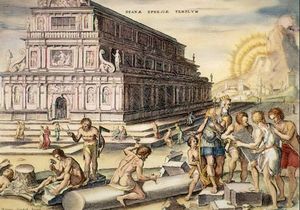
Temple of Artemis as depicted in hand-colored engraving by Martin Heemskerck
The Temple of Artemis at Ephesus was one of the Seven Wonders of the World. Paul (of the Christian Bible) staged a violent protest at the site of this temple, burning magick books.
In about 550 B.C.E., Artemis was built a temple in the city of Ephesus, located in present-day Turkey. This temple was one of the seven wonders of the ancient world.
The temple itself was constructed of marble, and had a total of 127 columns. However, Artemis’ temple was burned to the ground on July 21, 356 B.C.E. The temple was then restored, only to be destroyed again by the Goths in 262 C.E.
One of the most famous surviving statues of Artemis is the Artemis of Ephesus (shown below). The round items held in between her arms are bull testicals, an ancient symbol of fertility and power.
—Copyright © 1998 Andromeda
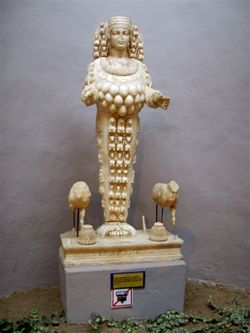
Pictures below show the famous Diane de Versailles statue of Artemis. On the left is the original statue and on the right is a reproduction of the statue that you can purchase from Sacred Source [external link, no connection with Pr Ntr Kmt].

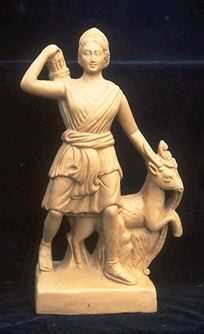
Artemis — The Huntress. See also Diana With Hound. The Amazonian moon-goddess, she was worshipped at Ephesus as Dea Anna, her entire torso covered with nurturing breasts. Here she is pictured running and in the act of drawing arrow from quiver, her doe companion at her side. Artemis’ bow is symbolic of both the crescent moon as well as of inner self-esteem, of an exquisitely-tuned inner tension. Like Kuan-Yin, she is the deity of wild places, groves and ponds. In Scythian myth she was related to the horned stag god Acteon (Kernunnos). She is the archetype of decisiveness. —picture and text © 1996 JBL Statues (now called Sacred Source), original text created by Tom Laudeman
Charge of the Goddess:
|
—courtesy of Aurora Lights Circle
|
religious title certificate
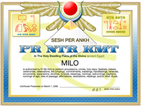
Get a beautiful certificate declaring that you are a priestess, priest, high priestess, high priest, witch, or shaman of Artemis. This is a real religious certificate meeting government standards for conducting marriages and other ceremonies.
See also Diana.
external links:
If you follow any of the links offered on this web site, no spell begging. Especially no love spell begging.
Herbs of Artemis by Metera.
Artemis “Artemis — The Immortals — Greek Mythology — From the Illiad to the Fall of the Last Tyrant” by Michael Stewart (OUTSIDE LINK)
The Seven Wonders: The Temple of Artemis at Ephesus (OUTSIDE LINK — PICTURE)
Artemis in Western Art NOTE that this link can only be reached from a .edu address, such as a college or university library
- Alone with attributes: bow and arrows
- Melian amphora (detail) (625 B.C.) For full, see APOLLO IV (OUTSIDE LINK — PICTURE NOTE that this link can only be reached from a .edu address, such as a college or university library)
- Pan Painter (detail of VII), Death of Aktaion (c. 470 B.C.) (OUTSIDE LINK — PICTURE NOTE that this link can only be reached from a .edu address, such as a college or university library)
- Athens, Parthenon. east frieze. Artemis (447-432 B.C.) (OUTSIDE LINK — PICTURE NOTE that this link can only be reached from a .edu address, such as a college or university library)
- Hellenistic relief (Krannon). Artemis as patron of animals (c. 350 B.C.) (OUTSIDE LINK — PICTURE NOTE that this link can only be reached from a .edu address, such as a college or university library)
- Pompeian wall painting. Artemis (1st cent. A.D.) (OUTSIDE LINK — PICTURE NOTE that this link can only be reached from a .edu address, such as a college or university library)
- Artemis as Potnia Theron
- Boeotian vase. Artemis (c. 680 B.C.) (OUTSIDE LINK — PICTURE NOTE that this link can only be reached from a .edu address, such as a college or university library)
- Kleitias. (Francois vase). Artemis (c. 570-560) (OUTSIDE LINK — PICTURE NOTE that this link can only be reached from a .edu address, such as a college or university library)
- Artemis as Selene
- Poussin Nicolas. Diana and Endymion (c. 1650) (OUTSIDE LINK — PICTURE NOTE that this link can only be reached from a .edu address, such as a college or university library)
- With Apollo and/or Leto (see under APOLLO IV)
- Pan Painter. Apollo and Artemis (c. 490 B.C.) (OUTSIDE LINK — PICTURE NOTE that this link can only be reached from a .edu address, such as a college or university library)
- Silver tetradrachma. Quadriga driven by Artemis (c. 460-409 B.C.) (OUTSIDE LINK — PICTURE NOTE that this link can only be reached from a .edu address, such as a college or university library)
- Villa Giulia Painter. Apollo and Artemis (460 B.C.) (OUTSIDE LINK — PICTURE NOTE that this link can only be reached from a .edu address, such as a college or university library)
- Barclay Painter. Apollo and Artemis (c. 450-440) (OUTSIDE LINK — PICTURE NOTE that this link can only be reached from a .edu address, such as a college or university library)
- Artemis as huntress
- Attic pelike. Artemis as deer hunter (c. 380 B.C.) (OUTSIDE LINK — PICTURE NOTE that this link can only be reached from a .edu address, such as a college or university library)
- Penni, Luca. Diana as huntress (c. 1550) (OUTSIDE LINK — PICTURE NOTE that this link can only be reached from a .edu address, such as a college or university library)
- Goujon, Jean. Diana of Anet (c. 1554) (OUTSIDE LINK — PICTURE NOTE that this link can only be reached from a .edu address, such as a college or university library)
- Renoir, Auguste. Diana (1867) (OUTSIDE LINK — PICTURE NOTE that this link can only be reached from a .edu address, such as a college or university library)
- In the Bath
- Coypel, Antoine. The bath of Diana (c. 1695) (OUTSIDE LINK — PICTURE NOTE that this link can only be reached from a .edu address, such as a college or university library)
- Watteau, Jean Antoine. Diana at her bath (c. 1715-1716) (OUTSIDE LINK — PICTURE NOTE that this link can only be reached from a .edu address, such as a college or university library)
- Boucher, Francois. Bath of Diana (1742) (OUTSIDE LINK — PICTURE NOTE that this link can only be reached from a .edu address, such as a college or university library)
- Death of Actaeon
- Pan Painter. Death of Actaeon (c. 470 B.C.) (OUTSIDE LINK — PICTURE NOTE that this link can only be reached from a .edu address, such as a college or university library)
- Selinus. Temple e metope. Death of Actaeon (c. 460 B.C.) (OUTSIDE LINK — PICTURE NOTE that this link can only be reached from a .edu address, such as a college or university library)
- Choephoroi Painter. Death of Actaeon (c. 350-340 B.C.) (OUTSIDE LINK — PICTURE NOTE that this link can only be reached from a .edu address, such as a college or university library)
- Titian. Actaeon and Diana (1559) (OUTSIDE LINK — PICTURE NOTE that this link can only be reached from a .edu address, such as a college or university library)
- Galloche, Louis. Diana and Actaeon (c. 1725) (OUTSIDE LINK — PICTURE NOTE that this link can only be reached from a .edu address, such as a college or university library)
- Nymph Kallisto
- Black Fury Group. Kallisto changing into a bear (370 B.C.) (OUTSIDE LINK — PICTURE NOTE that this link can only be reached from a .edu address, such as a college or university library)
- Apulian fragment. Kallisto with bear’s ears and paw (370 B.C.) (OUTSIDE LINK — PICTURE NOTE that this link can only be reached from a .edu address, such as a college or university library)
- Vermeer, Johannes. Diana and her nymphs (c. 1654) (OUTSIDE LINK — PICTURE NOTE that this link can only be reached from a .edu address, such as a college or university library)
click on picture for larger image
Marble statue of the Ephesian Artemis, Turkey. (125-175 A.D.)
Melian amphora (detail) (625 B.C.) NOTE that this link can only be reached from a .edu address, such as a college or university library
Alone with attributes: bow and arrows

Pan Painter (detail of VII), Death of Aktaion (c. 470 B.C.) NOTE that this link can only be reached from a .edu address, such as a college or university library
Athens, Parthenon. east frieze. Artemis (447-432 B.C.) NOTE that this link can only be reached from a .edu address, such as a college or university library
Hellenistic relief (Krannon). Artemis as patron of animals (c. 350 B.C.) NOTE that this link can only be reached from a .edu address, such as a college or university library
Pompeian wall painting. Artemis (1st cent. A.D.) NOTE that this link can only be reached from a .edu address, such as a college or university library
Artemis as Potnia Theron
Boeotian vase. Artemis (c. 680 B.C.) NOTE that this link can only be reached from a .edu address, such as a college or university library
Kleitias. (Francois vase). Artemis (c. 570-560) NOTE that this link can only be reached from a .edu address, such as a college or university library
Artemis as Selene
Poussin Nicolas. Diana and Endymion (c. 1650) NOTE that this link can only be reached from a .edu address, such as a college or university library
Artemis With Apollo and/or Leto
Pan Painter. Apollo and Artemis (c. 490 B.C.) NOTE that this link can only be reached from a .edu address, such as a college or university library
Silver tetradrachma. Quadriga driven by Artemis (c. 460-409 B.C.) NOTE that this link can only be reached from a .edu address, such as a college or university library
Villa Giulia Painter. Apollo and Artemis (460 B.C.) NOTE that this link can only be reached from a .edu address, such as a college or university library
Barclay Painter. Apollo and Artemis (c. 450-440) NOTE that this link can only be reached from a .edu address, such as a college or university library
Artemis as huntress
Attic pelike. Artemis as deer hunter (c. 380 B.C.) NOTE that this link can only be reached from a .edu address, such as a college or university library
Goujon, Jean. Diana of Anet (c. 1554) NOTE that this link can only be reached from a .edu address, such as a college or university library
Renoir, Auguste. Diana (1867) NOTE that this link can only be reached from a .edu address, such as a college or university library
Artemis in the Bath
Coypel, Antoine. The bath of Diana (c. 1695) NOTE that this link can only be reached from a .edu address, such as a college or university library
Watteau, Jean Antoine. Diana at her bath (c. 1715-1716) NOTE that this link can only be reached from a .edu address, such as a college or university library
Boucher, Francois. Bath of Diana (1742) NOTE that this link can only be reached from a .edu address, such as a college or university library
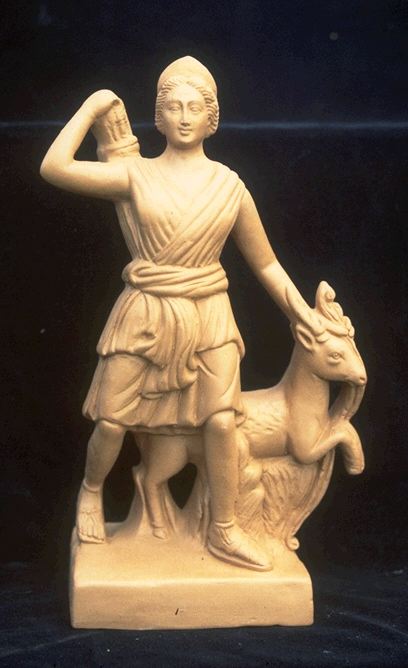
Picture courtesy of JBL Statues
this reproduction was sold by Sacred Source
JBL Statues is now Sacred Source
Diana at Ephesus (PICTURE)
If you have an Artemis-related web page, please send the URL to Milo. Please indicate if there is a picture on your web page.
Books
If you want your book reviewed, please send a copy to: Milo, POB 1361, Tustin, CA 92781, USA.
Homer, “The Odyssey”
Graves, Robert: “The Greek Myths, Part 1”
Aradia: Gospel of the Witches Expanded Edition; by Charles Godfrey Leland, with additional commentary by Mario Pazzaglini and others; Phoenix Publishing, Inc.; January 1999; ISBN 0919345344; paperback; 480 pages; $21.50
Aradia: Gospel of the Witches; by Charles Godfrey Leland; Phoenix Publishing, Inc.; 1899; ISBN 0919345107; paperback; $6.95
Aradia or the Gospel of the Witches; by Charles Godfrey Leland; Technology Group; 1899; ISBN 0939856549; paperback; $18.00
Aradia: The Gospel of the Witches; by Charles Godfrey Leland; Holmes Publishing Group; 1899; ISBN 1872189156; paperback; $8.95 + $0.85 special surcharge
Aradia: Gospel of the Witches [ABRIDGED]; by Charles Godfrey Leland, Barbara Marciniak (Narrator); Ten Speed Pr Audio; April 1998; ISBN 1574530399; audio cassette; $9.56
Moon Magick: Myth & Magick, Crafts & Recipes, Rituals & Spells (Llewellyn’s Practical Magick); by D. J. Conway; Llewellyn Publications; August 1995; ISBN 1567181678; paperback; 320 pages; $13.56
![]()
If you want your book reviewed, please send a copy to: Milo, POB 1361, Tustin, CA 92781, USA.















